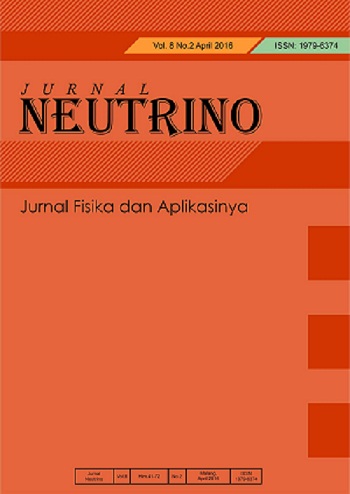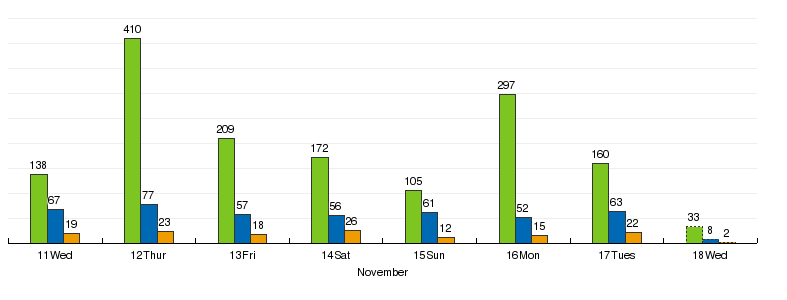THE EFFECT OF STATIC MAGNETIC FIELD EXPOSURE ON BODY WEIGHT AND ADIPOSE CELLS DENSITY OF OBESE MICE
Abstract
Obesity is a mojar public health problem in worldwide, especially in Indonesia. Obesity in addition to affecting productivity, is also trigger for other chronic disease such as diabetes and cardiac disease. Body mass index is an assessment tool used to assess degree of individual adiposity to define overweight, obesity, and severe obesity.The determination of obesity is based on the calculation of Body Mass Index (BMI), which devide body weight (kg) by height (cm2). In addition to the method of regulating diet, exercise, and bariatric surgery for weight loss, it was reported that the biophysical therapy tool, that is static magnetic field (SMF) became a modality for weight loss. Based on research reports, it proves that the static magnetic field affects weight loss in the group of obese mice after 30 days of exposure. Therefore, in this study, we carried out static magnetic field exposure to obese mice with a field intensity of 2 mT for 1 hour/day. Mice were exposed gradually to SMF on 2, 7, 14, and 21 days to determine the effectiveness of SMF to obesity in mice in terms of weight loss and cellular adipose cell density. The results showed that the weight of mice decreased significantly on 2nd and 7th days of exposure, the trend showed a decrease in body weight until the 14th day. The density of adipose tissue is increased after exposure to SMF on the 14th and 21st days of exposure. It showed that early exposure to SMF (2 and 7 days) could induce weight loss in mice, while cellularly SMF increased adipose cell density on late exposure (14 and 21 days).
Keywords
Full Text:
PDFReferences
Marquez MP, Alencastro F, Madrigal A, Jimenez JL, Blanco G, Gureghian A, Keagy L, Lee C, Liu R, Tan L, Deignan K. The role of cellular proliferation in adipogenic differentiation of human adipose tissue-derived mesenchymal stem cells. Stem cells and development. 2017 Nov 1;26(21):1578-95..
Corrales P, Vidal-Puig A, Medina-Gómez G. PPARs and metabolic disorders associated with challenged adipose tissue plasticity. International Journal of Molecular Sciences. 2018 Jul 21;19(7):2124.
Heimburger, D., and Weinsier, R. (1997). Obesity. In ‘‘Handbook of Clinical Nutrition,’’ 3rd ed. Mosby-Year Book, St. Louis, MO.
Harbuwono DS, Pramono LA, Yunir E, Subekti I. Obesity and central obesity in Indonesia: evidence from a national health survey. Medical Journal of Indonesia. 2018 Sep 9;27(2):114-20.
Rogers P, Webb GP. Estimation of body fat in normal and obese mice. British Journal of Nutrition. 1980 Jan;43(1):83-6.
Tschöp M, Heiman ML. Rodent obesity models: an overview. Experimental and clinical endocrinology & diabetes. 2001;109(06):307-19.
Wang CY, Liao JK. A mouse model of diet-induced obesity and insulin resistance. InmTOR 2012 (pp. 421-433). Humana Press.
Abou-Saleh RH. Assessment of biological changes of continuous whole body exposure to static magnetic field and extremely low frequency electromagnetic fields in mice. Ecotoxicology and environmental safety. 2008 Nov 1;71(3):895-902.
TSUJI Y, NAKAGAWA M, SUZUKI Y. Five-tesla static magnetic fields suppress food and water consumption and weight gain in mice. Industrial health. 1996;34(4):347-57.
Tian X, Wang D, Feng S, Zhang L, Ji X, Wang Z, Lu Q, Xi C, Pi L, Zhang X. Effects of 3.5–23.0 T static magnetic fields on mice: a safety study. Neuroimage. 2019 Oct 1;199:273-80.
Wang S, Luo J, Lv H, Zhang Z, Yang J, Dong D, Fang Y, Hu L, Liu M, Liao Z, Li J. Safety of exposure to high static magnetic fields (2 T–12 T): a study on mice. European Radiology. 2019 Nov;29(11):6029-37.
Yu B, Liu J, Cheng J, Zhang L, Song C, Tian X, Fan Y, Lv Y, Zhang X. A static magnetic field improves iron metabolism and prevents high-fat-diet/streptozocin-induced diabetes. The Innovation. 2021 Feb 28;2(1):100077.
Akimoto S, Miyasaka K. Age‐associated changes of appetite‐regulating peptides. Geriatrics & gerontology international. 2010 Jul;10:S107-19.
Morley JE. Decreased food intake with aging. The Journals of Gerontology Series A: Biological Sciences and Medical Sciences. 2001 Oct 1;56(suppl_2):81-8.
Wolden-Hanson T, Marck BT, Smith L, Matsumoto AM. Cross-sectional and longitudinal analysis of age-associated changes in body composition of male Brown Norway rats: association of serum leptin levels with peripheral adiposity. Journals of Gerontology Series A: Biomedical Sciences and Medical Sciences. 1999 Mar 1;54(3):B99-107.
Friedman JM, Halaas JL. Leptin and the regulation of body weight in mammals. Nature. 1998 Oct;395(6704):763-70.
Chaves VE, Frasson D, Kawashita NH. Several agents and pathways regulate lipolysis in adipocytes. Biochimie. 2011 Oct 1;93(10):1631-40.
Murphy RA, Register TC, Shively CA, Carr JJ, Ge Y, Heilbrun ME, Cummings SR, Koster A, Nevitt MC, Satterfield S, Tylvasky FA. Adipose tissue density, a novel biomarker predicting mortality risk in older adults. Journals of Gerontology Series A: Biomedical Sciences and Medical Sciences. 2014 Jan 1;69(1):109-17.
DOI: https://doi.org/10.18860/neu.v15i1.16302
Refbacks
- There are currently no refbacks.
Copyright (c) 2022 Puji Sari, luluk yunaini, Widia Bela Oktaviani, Umiatin Umiatin, Anita Dwi Suryandari

This work is licensed under a Creative Commons Attribution-NonCommercial-ShareAlike 4.0 International License.
Published By:
Program Studi Fisika Fakultas Sains dan Teknologi Universitas Islam Negeri (UIN) Maulana Malik Ibrahim Malang, Indonesia
B.J. Habibie 2nd Floor
Jl. Gajayana No.50 Malang 65144
Telp./Fax.: (0341) 558933
Email: neutrino@uin-malang.ac.id
This work is licensed under a Creative Commons Attribution-NonCommercial-ShareAlike 4.0 International License
View My Stats










